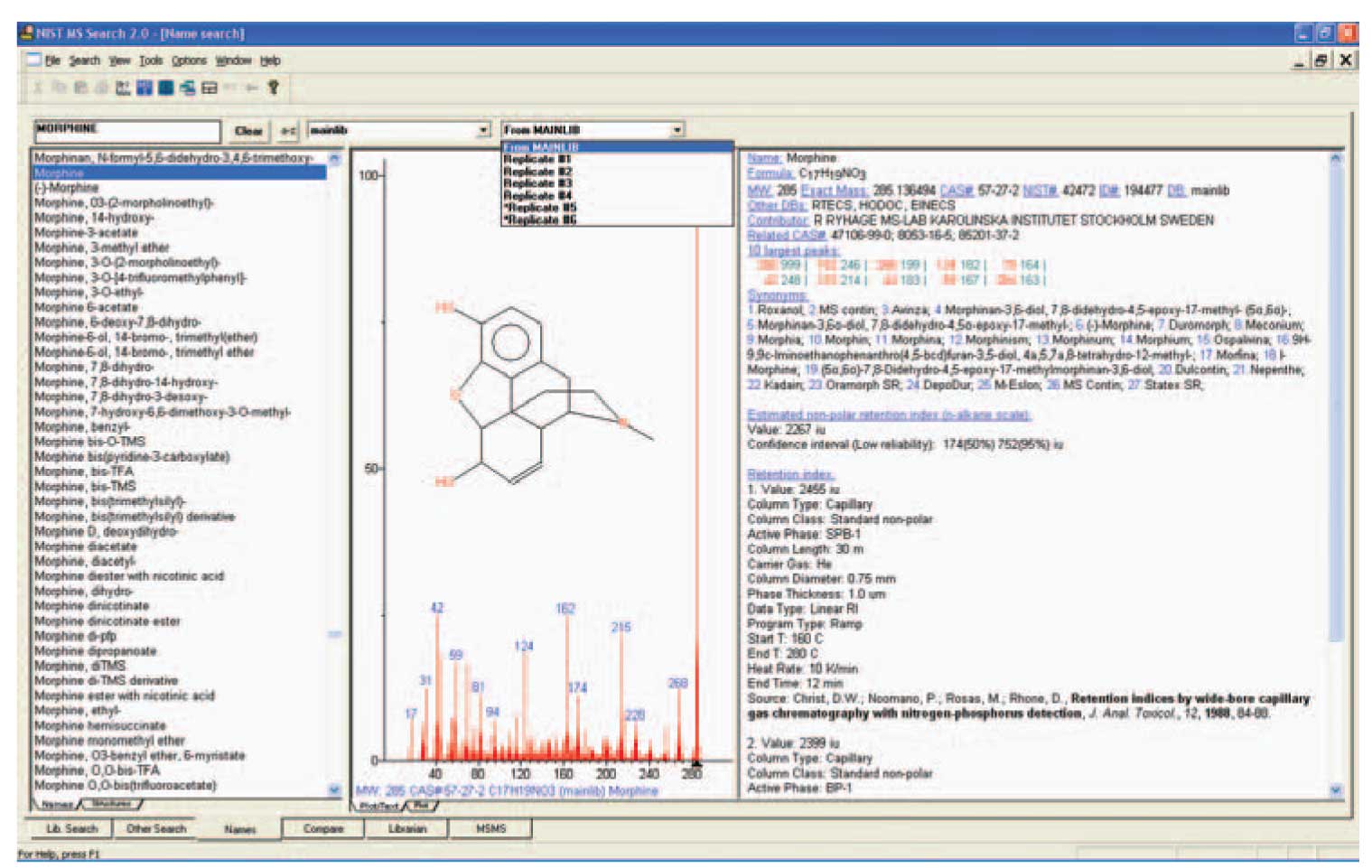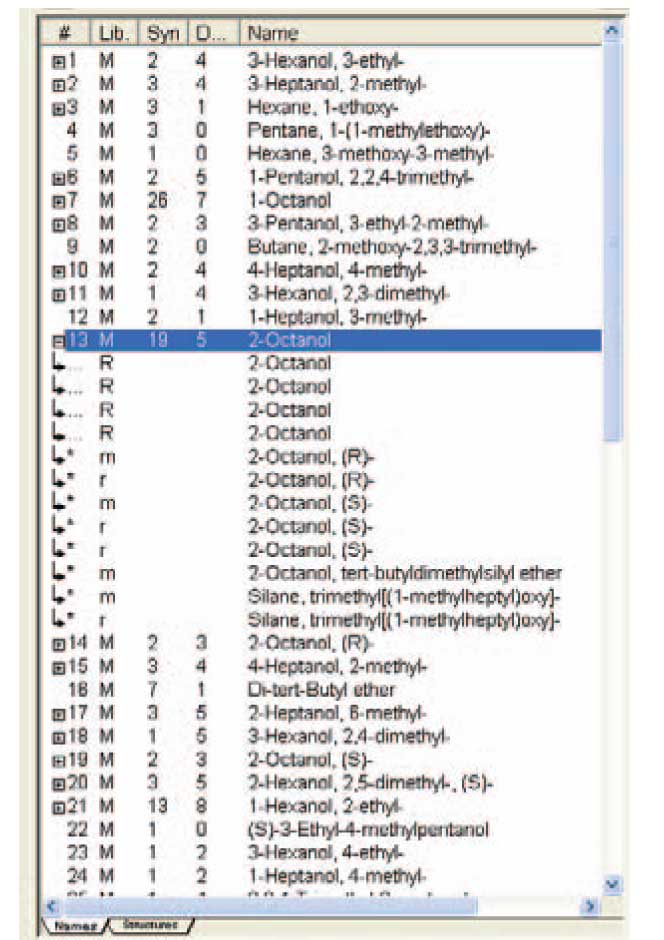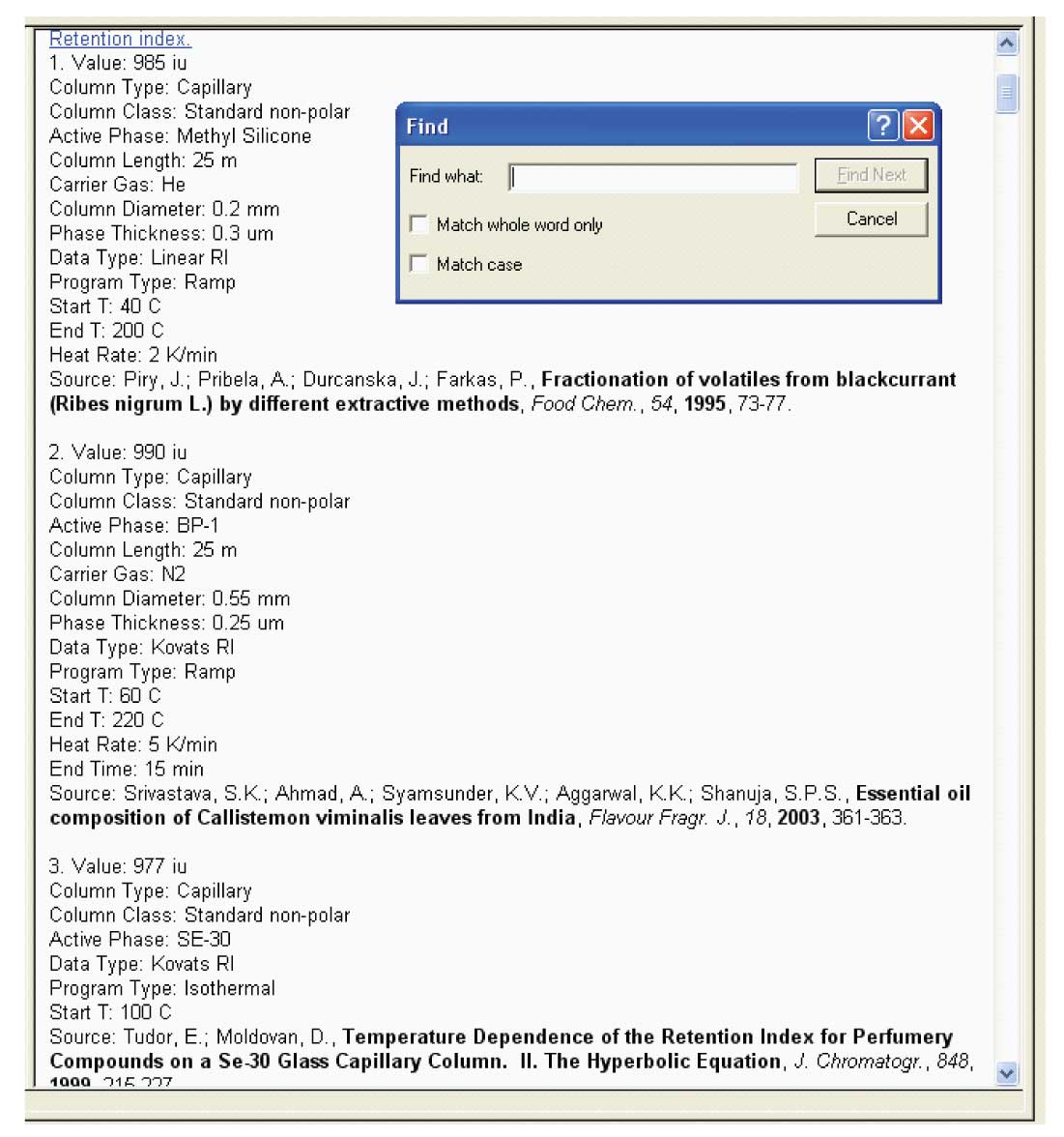This installment in the series on NIST 11 (National Institute of Standards and Technology) is about the Incremental Name Search , replicate spectra, and the NIST GC Methods, and Retention Index Database.
Early database search capabilities associated with manufacturers’ mass spectrometry data systems required that a spectrum of a compound of interest be searched in order to view the spectrum (or spectra) for that compound in the database. This was often very frustrating. If a mass spectrum of a specific compound needed to be viewed, the analyst would have to run down to the stockroom, search for the compound, bring it back to the laboratory, prepare the sample, inject it into the GC, and wait for the spectrum to appear so that the spectrum could be searched against the database to be able to view the database spectrum. This is one of the reasons why the Incremental Name Search was developed in the very first version of the NIST MS Search Program.
 Figure 1: The Incremental Name Search Window with the splitter bar between the Plot display of the spectrum and Text Info orientated in the vertical position. The position of this splitter bar can be changed by placing the Mouse pointer on either pane, clicking the Right Mouse button, and selecting the Change Splitter Orientation option. The dropdown-list box contains a list of replicate spectra, each of which can be individually displayed by using the Mouse pointer and the left Mouse button to select the desired one.
Figure 1: The Incremental Name Search Window with the splitter bar between the Plot display of the spectrum and Text Info orientated in the vertical position. The position of this splitter bar can be changed by placing the Mouse pointer on either pane, clicking the Right Mouse button, and selecting the Change Splitter Orientation option. The dropdown-list box contains a list of replicate spectra, each of which can be individually displayed by using the Mouse pointer and the left Mouse button to select the desired one.
As is understood by anyone working with organic compounds, a given compound can be known by multiple names: IUPAC, ACS, common and trade names, etc. For this reason, many of the compounds in the NIST EPA/NIH Mass Spectral Database have multiple synonyms associated with them in addition to what is referred to as the “mainlib name”. For example, the compound used to calibrate the m/z scale in a GC/MS instrument, perfluorotributylamine (mainlib name), has 22 synonyms including such esoteric designations as FC 43, PFTBA, and NSC 3501. Being able to search a database using common names, trade names, and chemical names resulting from established nomenclature rules can be very convenient.

Figure 2: Display of the replicate spectra for 2-octanol from a Formula Search of the mainlib database for C8H16O. The R means that the spectrum is in the replib database and is an actual replicate for the compound in the mainlib. The m designates a spectrum of a derivatives or stereoisomers which is in the mainlib. The r designates spectra of derivatives or stereoisomers that are in the replib.
Not only does an Incremental Name Search determine whether an electron ionization (EI) spectrum for the compound is in NIST 11, but it also determines whether a spectrum for the compound is in one of the NIST MS/MS Databases, the NIST GC Methods/Retention Index Database or some third-party mass spectral database. This search can be applied to any mass spectral database in the NIST format, including the Wiley Registry . As seen in Figure 1, an Incremental Name Search performed against a mass spectral database results in a bar-graph spectrum for the compound and, depending on the set properties for the Text Information Pane, a host of other useful information, such as the Chemical Abstracts Services registry number (CASrn), the compound’s nominal and monoisotopic masses, other databases containing a reference to the compound, the contributor of the spectrum, numeric values for the ten m/z value:intensity pairs that constitute the ten most intense peaks, a table of the m/z values (with non-zero intensities) and their intensities, and, most importantly in the case of EI spectra, whether there are GC methods available for the compound if the search is of NIST 11.
The Incremental Name Search , performed from the Names tab view (Figure 1), allows names to be typed into the text entry box just to the left of the Clear button on the top left of the display. Depending on whether the a-z button (to the right of the Clear button) is selected, the name should be entered with or without numerals; i.e., 3heptanone (with numerals) or heptanone (without numerals when the a-z button is selected). When the a-z button is selected, entered numerals will be ignored. When entering both alpha and numeric characters, commas, dashes, and primes as well as spaces will be ignored. Greek letters associated with names can be pasted into the Name Search text entry box. The Clear button clears all the characters in the text entry box. As the name is typed, the list of names in the pane on the left is updated. Optionally (selectable in the Properties dialog box), the Plot and Text Info panes of the Names view are also updated to the defaulted spectrum in the list, which is always the second entry. A different entry in the list can be displayed by selecting it using the Mouse pointer and left Mouse button. The dropdown list box to the right of the a-z button shows the name of the database being searched. Only one database at a time can be searched; however, the list of available databases can have as many as 127 different entries.

Figure 3: The Name Search Properties dialog box’s Text Info tab display indicating where setting for the display of GC methods/RI values are made.
The NIST/EPA/NIH EI Mass Spectral Database has only one spectrum per compound. There are replicate spectra (spectra of the same compound from different sources) in the replib database. These replicate spectra are linked to the spectra in the mainlib by CASrn. If replicate spectra are available, a dropdown list box to the right of the one showing the current database will be displayed. A list of replicate spectra will be displayed when the dropdown button of this box is selected. Each replicate spectrum is given the name Replicate #X , where X is a numerical value. In some cases, following the last Replicate #X entry, there will be entries labeled *Replicate #X . Depending on what is checked in the Replicates Display Options dialog box (displayed by selecting Options on the Main Menu bar and then selecting Replicates from the Options menu) these will be spectra of derivatives and/or stereoisomers of the compound. This is especially handy in being able to quickly view the mass spectrum of a trimethylsilyl derivative of an aliphatic alcohol. This display of replicate/derivative/stereoisomer spectra from the NIST replib and mainlib is available when non-NIST databases such as the Wiley Registry are searched as long as the compound entries in these databases have associated CASrn’s. Replicates can also be displayed from any type of search (Formula , Exact Mass , MW , etc.) when performed with the NIST MS Search Program (See sidebar above for additional information).
As pointed out in Part 1 of this series, a database of 346,757 GC Methods and Retention Indices for polar and non-polar columns, on both packed and capillary columns, and acquired isothermally and using temperature programming is included with NIST 11. When a search is performed against the mainlib , the first two GC methods and retention indices associated with that compound will be displayed (provided that there are entries in the GC method/RI value database), as seen in the right pane of the Name tab view (Figure 1). All information needed to perform a GC analysis is provided in these records. As these GC methods/RI values were mostly taken from the literature, the literature citation is also provided, including the complete title of the article from which the information originates. NIST is continually measuring spectra for the EI Database (both for new compounds and to replace poorer quality spectra), and is now capturing all the GC method/RI value information associated with such measurements. In many cases the NIST MS Search Program will calculate an estimated non-polar retention index on an n -alkane scale. This is especially useful where no GC method/RI value is available for the compound. The GC method/RI database has records for 70,835 compounds. Only 38,648 of the compounds have EI spectra in NIST 11. The information regarding those compounds for which EI spectra are not available can be retrieved by searching the nist_ri database. It should be noted that the GC method/RI value records can be retrieved using searches other than just the Incremental Name Search . It is also possible that when a MW , Formula , Exact Mass , or another type of search is being carried out that the nist_ri database can be included with mass spectral databases that are being searched so that GC methods/RI value records that are associated with compounds where no spectra are available are also retrieved.

Figure 4: Display of the string-search dialog box for the Find option displayed in the Text Info pane of a search result using the Right Mouse button menu.
The number of GC method/RI value records displayed in the Text Info pane is controlled by the Search Properties dialog box shown in Figure 3 for the Name Search . When a large number of GC method/RI value records are associated with a compound such as 2-octanol, which has 69 records, display of search results can be inhibited due to the speed of the computer used. This is why the default display is limited to the first two records; however, once all the records are displayed, it is possible to perform a string search of the Text Info pane by choosing Find from the right mouse button menu (Figure 4). This feature is new to the version of the NIST MS Search Program distributed with NIST 11. If a method using a specific stationary phase is desired or if the compound is in a specific matrix that may be a part of the title of the article from which the values were taken, this feature can be very handy.
NIST does offer the GC Methods/RI Database as a standalone product with a specialized search program which allows for better interrogation of this database than can be accomplished with the NIST MS Search Program . Even though many users already have the GC methods/RI values database included with NIST 11, they will purchase this standalone version in order to gain access to the search program especially designed for it.
The Incremental Name Search is a very valuable tool in getting information about compounds when just a name is available, especially if that name is a common or trade name. Next to the spectral matching searches, this is one of the most widely uses searches in the NIST MS Search Program.
The next installment in this series will cover the use of the NIST/EPA/NIH EI Mass Spectral Database and the NIST MS Search Program in determining the structure of compounds whose mass spectrum comes from collisionally activated dissociation (CAD) of ions representing intact molecules produced by LC/MS.
